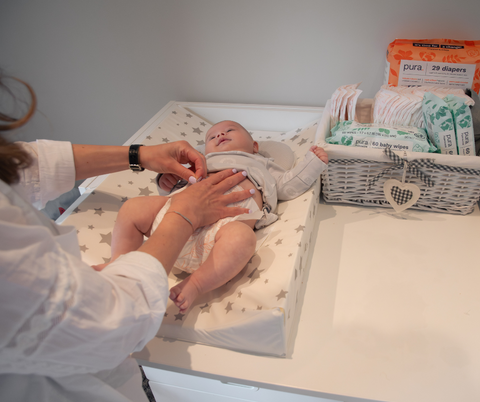Less diaper-free time and layering of clothing can make your baby more prone to diaper rash in the colder winter months, leaving their delicate bottoms sore and irritated. Don’t worry, our guide is here to help!

What is diaper rash?
Diaper rash is a skin irritation that appears around your baby’s diaper area. Nappy rash is common in babies and toddlers. It can be very mild or quite severe and can appear quite quickly and for no obvious reason. Diaper rash can include:
- red or raw patches on your baby’s bottom or the whole diaper area
- skin that looks sore and feels hot to touch
- scaly and dry skin
- an itchy or painful bottom
- your baby seeming uncomfortable or distressed
- spots, pimples, or blisters on bottom (spots can appear red or brown, but may be less noticeable on brown and black skin)
How can I prevent and treat diaper rash in winter?

The advice for preventing and treating diaper rash is largely the same. Always make sure you change wet or dirty nappies as soon as possible. Although this is more difficult in winter, you should also try to and leave your baby’s diaper off for as long as possible after a change, or after a bath, giving your baby’s bottom much needed air time.
When changing your baby’s diaper after a poo or wee, ensure your baby’s bottom is clean and dry. You can wipe your baby's bottom with fragrance-free and alcohol-free baby wipes
like Pura’s to avoid any irritation. Pura’s wipes are EWG Verified and approved by Allergy UK and The British Skin Foundation to be gentle on eczema prone and sensitive skin.
Once they’re clean, gently pat the bottom area with a muslin cloth to dry it before applying a new diaper. Be careful when bathing your baby, do not use soaps, baby lotion, bubble bath or talcum powder as these could irritate the skin.
When it comes to diapers, use those that are extra absorbent like Pura’s, which have up to 12 hours leak free protection (size 3 upwards) to keep bottoms healthy and dry.
Make sure your baby's diaper fits properly too, as a tight nappy can irritate the skin – see our guide on how to get the right fit here.
This advice should help prevent diaper rash and treat mild cases. You can also look for over the counter creams to soothe worse cases of diaper rash – ask your pharmacist for advice.
When to seek help
You should see a doctor if your baby's diaper rash does not go away, gets worse or spreads to other areas or if your baby has a high temperature or seems uncomfortable. Your doctor can provide medicated creams for the more severe cases of nappy rash.
Disclaimer: The content contained in this article is for informational purposes only and should not be taken to represent professional or medical advice. Always seek advice from a medical professional when deciding on what is best for you and your baby.








